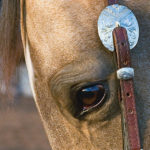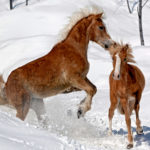Maybe I just have a heightened awareness right now, but I think I am seeing more thin horses as I drive by pastures through the countryside.? Like many of my colleagues, I am concerned about the status of horses this winter, as hay is scarce and feed prices continue to rise. ?Even without a bad economy and high feed prices, we are always concerned about ?winter starvation?.? Many horse owners, especially those of us in cold climates, will give horses a break throughout the winter.? This usually means the horse is turned out, riding frequency is nil to none, and basic care like grooming and shoeing slows way down. ?Unfortunately, long and shaggy winter coats can easily camouflage protruding ribs or even excess fat. You have probably observed that 150 pounds looks better on some people than others, and the same is true for horses. Body condition scoring (BCS) estimates the amount of fat covering on a horse. Estimating the fat stored on a horse will help determine if the horse is too fat, too thin, or just right. Weight measurements do not consider the body composition of the horse. ?Imagine two horses both weighing 1000 pounds each and standing 15 hands (60 inches) high. If one horse is heavier boned and has more muscling, that horse will have less body fat stores than its finer boned, lighter muscled counterpart, even though their weight and height are the same. Estimating Body Condition Scores When estimating BCS, look at the horse and ?examine the areas where external body fat is stored. Stand about 10 feet away from the horse and appraise the top of the horse’s neck, shoulder, back, and hip. Is there a smooth or angular appearance to the top line? Can you see ribs? Does the shoulder blend smoothly into the horse’s front flank? Can you see a crease running down the center of the horse’s back, or is it flush or tent-shaped with the backbone protruding upwards? Visual appraisal can only take you so far in the wintertime.? You will need to feel through the horse’s winter hair coat to get a sense of the fat covering along their neck, ribs and topline. ? Can you easily feel the ribs, or do you have to press and rub hard before you can even imagine the rib cage? Fat Horse Cheat Sheet I often use my hand as a reference guide for what I am feeling underneath all of that hair. ?Close your eyes and feel the fleshy part of your hand where the thumb attaches to your palm. It feels plumb, soft and fleshy. ?It is hard to find the bone as you press your palm. This is a similar feel to the rib cage of a horse with a lot of fat cover over the ribs (BCS ?7). Moderate Horse Cheat Sheet Now make a fist and feel the long bones of your fingers right above your knuckles. While you can make out each individual finger, overall it is still fairly smooth, which is a similar feel to the rib cage of horse in a moderate BCS (BCS = 5). Thin Horse Cheat Sheet Now, keeping your hand in a tight fist, run your other hand over your knuckles and notice the jutty, rigid feel. The ribs of a thin horse will likewise feel pointed and distinct (BCS < 4). TEST YOUR SKILLS at Body Condition Scoring by trying this activity from eXtension.org/horses.Optimum Body Condition Score The optimum body condition score should be determined on an individual basis, considering the horse’s workload, age, and production status as primary factors. A young growing horse should be developing healthy skeletal and muscle tissue. Both clinical and field observations suggest that excess weight can cause a growing horse to have bone abnormalities, especially if there is a genetic predisposition to developmental orthopedic disease. A goal of a moderate body condition score of 5 would guard a healthy young horse from unnecessary fat that would burden developing bone tissue. A performance horse needs body fat stores to provide energy for exercise. Too much body fat can decrease performance and hinder a horse’s ability to dissipate heat during hot weather. However, a thin horse does not have enough energy stored to maintain a high performance level. An optimum BCS for a performance horse ranges from 5 through 7, depending on its work requirements. For example, a draft horse used for pulling would be kept closer to a BCS of 7 while a racehorse would be kept closer to a BCS of 5. ??A broodmare’s energy demands double once a foal is delivered and begins to nurse. A mare has her highest energy needs during peak milking period. A thin mare will have a higher incidence of reproductive failure, that is, failure to conceive or early abortion, than a mare kept in a moderate to fleshy condition. Thus a breeding manager should keep a broodmare no lower than a moderate BCS (5) during breeding and gestation. Preferably a broodmare should foal in a BCS of 6?and 7 to ensure that she is at least a BCS 5 during peak lactation. Prior to gestation, a mare should have adequate body fat stores to approach the breeding shed at a moderate body condition (BCS 5). A geriatric horse should be maintained at a condition score of 5.5?through 6.5. An older horse tends to have a more difficult time gaining weight. A horse with Cushing?s Disease may also be harder to score as a result of a long hair coat. The most important aspect of body condition scoring is to accurately determine if your horse is thin, moderate or fat.? If your horse is in the moderate range, congratulations!? You are doing a good job of balancing your horse’s energy needs with his energy intake.? If your horse is thin, then you need to work with your veterinarian or a nutritionist to get your horse into the moderate range.? If your horse is fat, don’t be smug.? A fat horse is more prone to nutritionally related diseases.? You should also work with a veterinarian and/or nutritionist to get your horse to a more moderate and safer body condition score.













